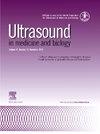Imaging Behind the Plaque: Improved Blood Flow Quantification Using an Iterative Scheme for Active Attenuation Correction
IF 2.4
3区 医学
Q2 ACOUSTICS
引用次数: 0
Abstract
Objective
Blood flow quantification using high frame-rate (HFR), contrast-enhanced ultrasound followed by particle image velocimetry (PIV), termed echoPIV, allows the study of blood flow phenomena in diseased arteries before and after treatment. However, acoustic shadows caused by atherosclerotic plaques may lead to incomplete flow quantification. As a global increase in transmit pressure to compensate for the attenuation would lead to contrast agent destruction in unattenuated areas, this article proposes a method to locally enhance the signal amplitude, thereby improving flow quantification accuracy.
Methods
The acoustic pressure was locally increased by adjusting the transmit apodization of the transducer elements using a proportional integral controller coupled to an acoustic model based on the Rayleigh integral. These iterative adjustments were performed prior to the HFR recording. This iterative scheme for active attenuation correction (ISAAC) was applied in vitro on phantoms with different levels of attenuation. A PIV analysis was then performed on each of the recorded HFR datasets.
Results
Without ISAAC, using a driving voltage of 11.2V, the mean errors in velocity estimates were below 20% for attenuation values up to 6.4 dB. Using ISAAC, the errors were reduced to less than 10% for attenuation values up to 8.5 dB and to less than 20% for attenuation up to 10.6 dB.
Conclusion
The proposed iterative scheme for attenuation correction was shown to compensate effectively for acoustic signal loss in acoustic shadows. ISAAC led to an improved accuracy in echoPIV-derived flow velocities.
斑块背后的成像:使用主动衰减校正的迭代方案改进血流量化。
目的:采用高帧率(HFR)、对比增强超声和粒子图像测速(PIV) (echoPIV)进行血流量化,可以研究治疗前后病变动脉的血流现象。然而,由动脉粥样硬化斑块引起的声学阴影可能导致血流定量不完整。由于通过增加传输压力来补偿衰减会导致未衰减区域的造影剂破坏,本文提出了一种局部增强信号幅度的方法,从而提高流量量化精度。方法:采用基于瑞利积分的声学模型与比例积分控制器耦合,通过调整换能器元件的传输距离,局部增加声压。这些反复调整在HFR记录之前进行。这种迭代的主动衰减校正(ISAAC)方案在体外应用于不同衰减水平的幻影。然后对每个记录的HFR数据集进行PIV分析。结果:在没有ISAAC的情况下,使用11.2V的驱动电压,对于衰减值高达6.4 dB的速度估计的平均误差低于20%。使用ISAAC,当衰减值高达8.5 dB时,误差降低到10%以下,当衰减值高达10.6 dB时,误差降低到20%以下。结论:所提出的衰减校正迭代方案能够有效地补偿声阴影中的声信号损失。ISAAC提高了echopiv导出的流速的准确性。
本文章由计算机程序翻译,如有差异,请以英文原文为准。
求助全文
约1分钟内获得全文
求助全文
来源期刊
CiteScore
6.20
自引率
6.90%
发文量
325
审稿时长
70 days
期刊介绍:
Ultrasound in Medicine and Biology is the official journal of the World Federation for Ultrasound in Medicine and Biology. The journal publishes original contributions that demonstrate a novel application of an existing ultrasound technology in clinical diagnostic, interventional and therapeutic applications, new and improved clinical techniques, the physics, engineering and technology of ultrasound in medicine and biology, and the interactions between ultrasound and biological systems, including bioeffects. Papers that simply utilize standard diagnostic ultrasound as a measuring tool will be considered out of scope. Extended critical reviews of subjects of contemporary interest in the field are also published, in addition to occasional editorial articles, clinical and technical notes, book reviews, letters to the editor and a calendar of forthcoming meetings. It is the aim of the journal fully to meet the information and publication requirements of the clinicians, scientists, engineers and other professionals who constitute the biomedical ultrasonic community.

 求助内容:
求助内容: 应助结果提醒方式:
应助结果提醒方式:


